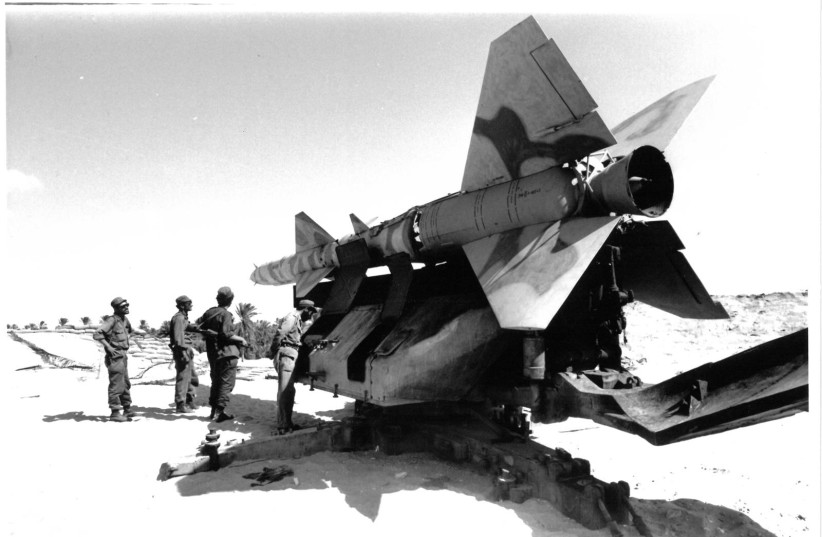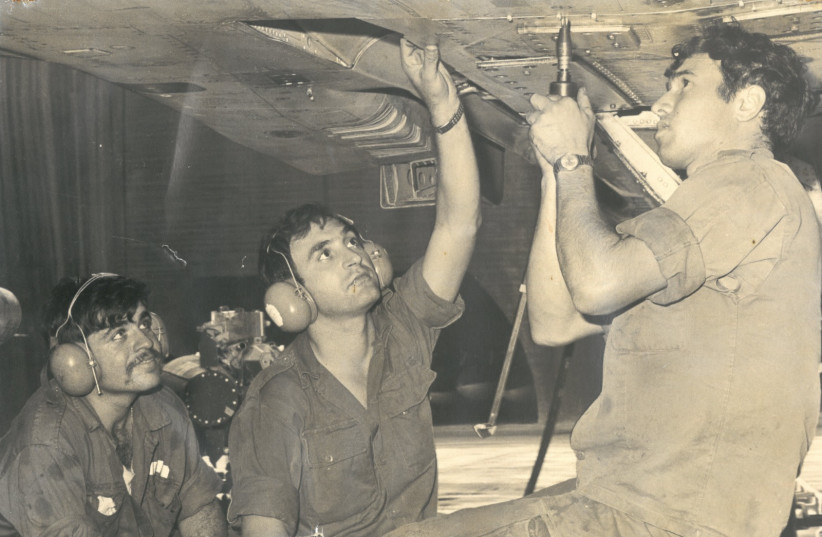New documents released by the IDF to commemorate the 50th anniversary of the Yom Kippur War show the systematic approach by the Israel Air Force to improve and learn lessons from the conflict.
"The main lessons developed from the Yom Kippur War, regarding the building of the force and its operation, are relevant today and will stay relevant also in the future," Colonel Eli Cohen wrote in a 1982 Air Force Planning Directorate summary.
As the IDF was learning new lessons from Operation Peace for Galilee, Cohen said it was a suitable time to review the impact of the Yom Kippur on the air force.
The Air Force had addressed almost all of the failures in the war, explaining that in the few cases that lessons were not applied it was due to limitations of resources and having to prioritize more vital issues.
One example was a dedicated transport wing, but the IAF did increase the number of transport craft from 47 to 55. Between 1973 and 1982 it phased out the Nord Noratlas and purchased Boeing 707s and more Lockheed C-130 Hercules. These Hercules transport craft are still in use by the Air Force.

Surface-to-air missiles
One of the most devastating weapons that the IDF encountered during the war were surface-to-air missiles (SAMs) batteries which diminished the Israeli Air Force's capabilities on the front lines.
The IAF said that it had changed its perception of how to deal with SAMs at all levels of staff. This included training pilots in avoidance and counterattack against batteries. To avoid attack from 2K12 Kub SAM systems, chaff pods were given to every fighter craft, and SAM warning systems were installed in every aircraft by 1982 - excepting some Skyhawk models, some light helicopters, and the transport craft.
For attack, the military pursued the procurement of standoff-capable weapons, which allowed the launch of weapons outside the range of ground defenses. The IAF also invested in more anti-radiation missiles that could lock on the SAM radar systems.
Improved air defenses
Israel also realized that it needed to improve its own air defenses, in particular what it dubbed successful "medium" caliber anti-air cannons. This led to the purchase of M163 Vulcan Air Defense Systems and M-48 Chaparral SAM systems which provide greater "accuracy, rate of fire, destructive power and greater effectivity" than the anti-air cannons previously in use. The IDF also bought two more Raytheon MIM-23 HAWK batteries in the post-war years to address the need to expand SAM arrays.
A denser detection system was developed with the purchase of new radars. Sinai detection posts had to be moved with the Israeli evacuation of the peninsula. Today, Israel is a leading developer of air defense systems, perhaps most famously the Iron Dome. Last Thursday Israel signed a historic agreement to supply Germany with its Arrow-3 long-range anti-ballistic missile system.
Concern remained over chemical and biological attacks post-Yom Kippur War, leading to the protection of facilities against non-conventional weapons and the distribution of protective equipment to troops and training them in their use, though it was noted they really hadn't encountered a real scenario to prove their effectiveness. Command posts and forward positions were hardened against conventional attack, the latter built in cooperation with IDF ground forces.

New bases, new planes
Additional combat air bases were built between 1973 and 1982, increasing the IAF's airfields from 4 to 7. Several emergency landing fields were also established. Ramon Airbase was built to replace the Eitam Airbase in north Sinai.
The aircraft that came to be stationed at these bases have become mainstays of the Israeli air fleet -- squadrons of McDonnell Douglas F-15 Eagles and General Dynamics F-16 Fighting Falcons were purchased to address multiple needs. One failing of the Yom Kippur War was that of better nighttime combat. The American-made warplanes were equipped with advanced radar and missile systems that allowed for air-to-air combat at night.
Israel also addressed the need for more reliable and secure communications between planes and command, equipping jet models new and old with newly developed encrypted radios. It was noted that in 1982 they didn't have enough of a reserve stock for them. Another problem that wasn't met with the jets was the deed for interception of high-altitude aircraft. F-15 and Kfir jets were deemed not sufficient to intercept the Mikoyan-Gurevich MiG-25.
The IAF also sought an improved ability to strike strategic targets, which was aided by the purchase of the F-16s, F-15s, and air refueling planes. Older F-4 phantoms were also given the capability to refuel in the air. Israel armed these platforms for tackling strategic targets by developing and purchasing new guided and penetrating weapon systems.
"This capability proved itself, among other things, in the attack on the [Osirak reactor] core in Iraq," wrote Cohen.
Reconnaissance
Reconnaissance also needed to be improved to address strategic targets, which was addressed with more high-altitude photography using F-4 Phantoms. Investment in more reconnaissance craft also led to the production of more IAI Scout Unmanned Aerial Vehicles. Today, Israel has built on this early adoption of UAV technology to become a leader in the field.
The IAF addressed complaints that it had not been involved enough with ground combat by investing more in combat helicopters. A dedicated helicopter wing was established with three squadrons of helicopters and more helicopter bases were built. New scopes and sensors were introduced to help them operate better at night. New operation standards were also introduced to avoid unnecessary risks to light helicopters.
Light helicopters like the Aerospatiale Alouette II were phased out for more Bell-206, while the medium Bell-205 helicopters were replaced with 56 Bell-212s. Israel increased its fleet of heavy helicopters with additional units of Sikorsky CH-53 Sea Stallion and Aerospatiale AS 321 Super Frelon.
The IDF also sought to address the air-to-ground gap with a dedicated missile system against dug-in infantry, but the best solution had not yet been identified by 1982.

Changing the structure of the Air Force
The Air Force also said that it had changed the way that the unit was structured, with new departments for air, intel, equipment, and a body for air supplies units working with the land forces. A safety and quality control department was also introduced.
To address the problem of soldiers who were missing in action, a Missing Person's Unit was established in 1976. The MPU is still operating today, even finding the resting places of soldiers fallen in the War of Independence, as it did on Saturday.
Major-General Tomer Bar said in a statement marking the war's anniversary that the strength of the air force came from the foundations built by each successive generation.
"Over the years the Air Force studied, studied, tested, and applied the lessons and insights that emerged from that difficult war. Even in the last year, the Air Force continued to learn and re-assimilate its lessons," said Bar. "Many lessons were learned in the Air Force from that war and deepened every year and with every generation of pilots and ground crew through the learning procedures we held.”
Bar said that the Air Force was built on long chains of trust between the different teams, pilots and commanders, crew and cockpit, that worked to send aircraft into missions. A second element was dedication, which was demonstrated by the fighters in the Yom Kippur War, who went into battle knowing that they might not return. He recalled his own memories as a small boy, hearing Mirages, Skyhawks, and Phantoms loaded with bombs taking off.
"The events of the war serve as a bright warning sign for us and teach us to question even what we are sure we know," said Bar. "Just as we knew how to get back on our feet in the face of the events of the Yom Kippur War, so we will also know this time to continue to defend the State of Israel."
The Israeli Air Force lost over one hundred aircraft in the 1973 war. In all, 2,689 IDF servicemen were killed, thousands wounded, and hundreds taken captive.
